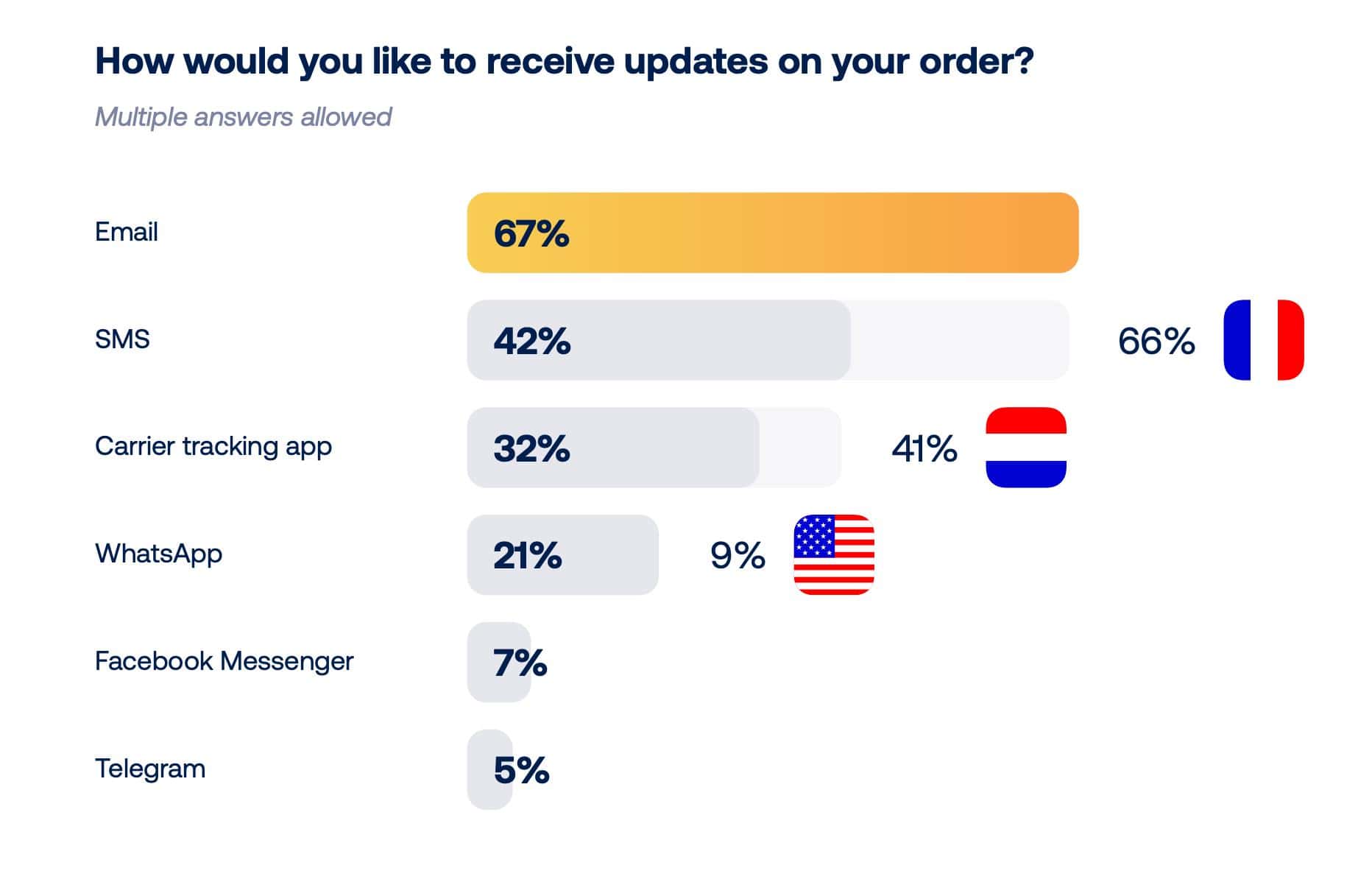If you run an e-commerce store or manage a customer service team, you’ve likely faced this: a flood of “Where is my order?” (WISMO) calls and emails. It’s tiring for your team, frustrating for your customers, and often a sign that your post-purchase experience could use some improvement.
The good news? Reducing WISMO is absolutely doable, and it can make a big difference for your business. Less stress for your team, happier customers, and more time to focus on growth.
In this article, we’ll cover what causes WISMO, why it’s a challenge, and 12 easy ways to reduce it—while keeping your customers smiling.
What is WISMO?
“WISMO” stands for “Where is my order?”—a common query from customers. Research shows WISMO calls can make up over 35% of customer support interactions, spiking even higher during busy shopping seasons.
These queries usually come through various support channels—email, calls, chatbots, live chat, SMS, or social media—mainly because customers want to know when their parcel will arrive. Often, WISMO calls include other delivery-related questions, making them more time-consuming.
What is WISMR?
Similar to WISMO, WISMR stands for “Where is my refund/return?” These queries, though less frequent, still generate significant call volumes, especially during peak periods, causing frustration for both customers and support staff.
“Customer question number one is ‘Where is my order?’”
Susan, Customer Service Manager at ByNouck
How does WISMO impact your business?
Reducing WISMO is crucial because these queries can negatively impact your business in several ways:
- Customer expectations: According to our 2023 E-commerce Delivery Compass, the average consumer expects delivery within 3.3 days and won’t wait longer than 4.9 days. High WISMO rates indicate your company is struggling to meet these expectations.
- Costs: Resolving WISMO calls costs an average of €5.50 each. For companies shipping thousands of parcels monthly, these costs add up quickly.
- Customer satisfaction: WISMO calls frustrate customers, damaging their perception of your business and potentially leading to negative reviews.
- Customer retention: Worst-case scenario, frustrated customers may stop buying from you. PWC research shows that 32% of customers will abandon a brand after just one bad experience.
Common Causes of WISMO
Identifying the root causes of WISMO is key to reducing these time-consuming queries and enhancing customer satisfaction. The most common factors include:
- Lack of tracking information: Customers are left in the dark when tracking updates are delayed or insufficient.
- Delivery delays: Operational challenges, weather disruptions, or carrier issues lead to unexpected slowdowns.
- Non-Deliveries: Packages might be misplaced, lost, or delivered to the wrong address, triggering confusion and frustration.
- Unclear delivery estimates: Vague or overly broad delivery windows leave customers uncertain about when to expect their orders.
- Customs clearance: International shipments often face hold-ups due to incomplete documentation or customs procedures.
- Order splitting: When items in a single purchase are shipped separately, customers may reach out repeatedly for each shipment’s status.
12 ways to reduce WISMO
Ready to simplify your customer experience? Here are 12 straightforward ways to cut them down and keep your customers happy.
1. Be realistic about delivery estimates
Avoid overpromising and underdelivering—literally. Use your historical shipping data, real-time carrier performance stats, and analytics tools to set realistic delivery times. Shipping platforms like Sendcloud let you monitor carrier performance, so you can choose reliable shipping partners and adjust delivery promises during peak seasons or delays.
For example: If a carrier averages five days for delivery during the holiday rush, update your site’s delivery estimate to reflect that. Transparency not only reduces WISMO calls but also builds trust with your customers.

2. Make sure your shipping and returns policies are crystal clear
Confusion leads to questions—so make sure your shipping and returns policies are simple, detailed, and easy to find. Place them where customers naturally look, like your website’s header, checkout page, and order confirmation emails.
Take inspiration from brands like PittaRosso, which smartly includes links to shipping FAQs on their tracking page. This proactive approach gives customers instant answers, cutting down WISMO calls before they even happen. Curious to learn more? Explore how PittaRosso turned retail challenges into e-commerce success by prioritizing customer experience.
Bonus tip: Use a FAQ format to address common concerns like delivery timelines, return windows, and refund processes.
3. Offer real-time updates and self-service tracking
Keeping customers informed goes a long way in reducing WISMO queries. A real-time tracking page branded to your store gives customers a quick and easy way to check their order status without contacting support. By simplifying access to shipment updates, you can dramatically cut down on inquiries.
For inspiration, take UK-based Sweetie Shoppie. By implementing a branded tracking page, they cut WISMO queries by 50%.

4. Deliver notifications via multiple channels
Not all customers check their email regularly, so it’s smart to use multiple channels for order updates. Combine email with SMS, WhatsApp, or even push notifications to ensure everyone gets the information they need, when they need it.
Did you know that while 67% of customers prefer email for updates, preferences vary widely? Offering choices lets customers pick what works best for them, reducing the likelihood of missed notifications—and the WISMO calls that follow.

5. Simplify carrier notifications
Carrier notifications often come in a jumble of technical terms and inconsistent formats, leaving customers scratching their heads. To fix this, streamline the process by consolidating updates into one clear, standardized system.
Did you know that inconsistent notifications are one of the top reasons customers feel frustrated during delivery? Even a minor delay feels worse when updates are unclear. Simplifying these messages not only reduces WISMO calls but also builds trust by showing you’re in control of the process.
Tip: If you work with multiple carriers, tools like integration platforms can help unify notifications across providers into a single, easy-to-follow format. This way, customers always get the same experience, no matter the carrier.
6. Equip customer service with smarter tracking tools
Some customers will still ask, “Where’s my order?”—even with great tracking. The solution? Give your support team direct access to tracking data in a centralized system. With everything in one place, they can quickly answer questions without the back-and-forth of switching apps or digging for details.
Smart systems can also flag delivery issues—like delays or missed deliveries—so your team can address problems before customers even notice.
Check out our guide to the 15 top shipment tracking software tools to find the best fit for your business.

7. Automate first-level customer service responses
Save your team’s energy for the tough questions by automating the simple ones. Chatbots and automated tools can handle routine WISMO queries, like tracking updates or delivery times. By integrating tracking data via API, your chatbot can provide real-time order status instantly, keeping customers informed without human intervention.
Take Vanessa Wu, for example. The women’s accessories brand significantly reduced WISMO queries by implementing automated responses for common shipping questions.
Pro tip: Ensure your chatbot offers clear, friendly replies and directs customers to a human agent if the issue requires deeper assistance.
8. Monitor and proactively inform customers about delivery issues
Delivery issues? They’re going to happen—it’s just part of the process. But here’s the key: don’t wait for your customers to come to you. Be proactive and let them know what’s happening as soon as you spot a delay or problem. From our experience, this simple step can reduce support tickets by as much as 75%.
Here’s how you can do it: use historical carrier data to predict delays or pinpoint where things might go wrong. If you know a certain carrier slows down during peak times, adjust your ETAs and notify customers early. It’s not just about fixing problems—it’s about showing customers you’ve got their back.
9. Protect your shipments
Lost, delayed, or stolen shipments can turn into major headaches—for both you and your customers. The good news? Insuring your shipments can provide peace of mind on both sides. It’s a simple way to show customers you’ve got them covered if something goes wrong.
Based on what we’ve seen, resolving claims quickly is key. For example, we’ve managed to settle 95% of claims within three days by streamlining the process. Consider setting up rules to automatically apply insurance to higher-value shipments or letting customers opt in at checkout. It’s all about minimizing risk and showing you care about their experience.
10. Offer same-day or next-day delivery
Let’s face it—waiting days for a package feels ancient. Customers today want their orders fast. In fact, our latest Delivery Survey shows that 45% prefer delivery on a specific date and time, and 42% want next-day delivery. Offering these options shows your business is keeping up with the times and helps cut down on those dreaded WISMO queries.
Even if not everyone chooses faster shipping, just having it as an option can make your shop stand out. It’s like saying, “We get you, and we’re ready to deliver—literally.” Start small by testing these faster options in select areas or for popular products, and watch how much happier your customers get.
11. Optimize delivery performance
Poor delivery experiences don’t just frustrate customers—they cost you money, too. To avoid this double hit, focus on improving your delivery performance. Start by using data and analytics to identify weak points, like late shipments or costly carriers. Automation can also streamline processes and help you work smarter, not harder.
Here’s a tip from experience: tracking carrier performance is a game-changer. Alex Formicola, Customer Support Lead at Rosefield, shared that having access to detailed performance insights helped their team gain better control over deliveries and negotiate more favorable terms with carriers. It’s proof that a little optimization can go a long way toward happier customers and healthier margins.
“With Shipping Intelligence, we gain control over our delivery process. Getting access to unique carrier performance insights allows us to negotiate better terms with the carriers.”
Alex Formicola, Customer Support Lead, Rosefield
12. Standardize shipping data
Managing shipments from multiple carriers can be messy. Different formats, tracking systems, and data streams—it’s a recipe for mistakes. The solution? Bring all that data together in one place. Think of it as creating one clear map instead of juggling ten different ones.
With everything standardized, you’ll catch tracking errors before they become problems. Plus, you can use a simple dashboard to monitor shipments or export the data to tools your team already uses. Want to take it up a notch? Send this data to a logistic intelligence tool to uncover trends—like which carriers are consistently late—and make smarter decisions going forward.
Real-life examples and case studies
Sometimes, the best way to learn is through examples. Here are a few businesses that tackled WISMO head-on and saw real results:
- PittaRosso: By making shipping information crystal clear from the start, this retailer drastically reduced WISMO queries. Clear expectations upfront meant fewer confused customers reaching out.
- Vanessa Wu: This brand implemented chatbots integrated with tracking data to handle first-level customer queries. The result? Support staff could focus on solving complex issues instead of answering “Where is my order?” all day.
- Sweetie Shoppie: With a branded tracking page, customers could easily check their order status without needing to contact support. The result? A 50% drop in WISMO-related inquiries.
- Travelbags: By using real-time monitoring for shipment exceptions, they cut WISMO requests by an impressive 39.2%. Proactively spotting and resolving delivery issues made a huge difference for their customers.
Each of these businesses proves that reducing WISMO isn’t just possible—it’s achievable with the right strategies.
Delivering more value with less WISMO
WISMO queries are a headache for everyone—your customers, your support team, and your bottom line. But the good news? They’re not inevitable. With clear communication, smarter tools, and proactive strategies, you can significantly reduce WISMO inquiries while creating a smoother, more satisfying customer experience.
By implementing these tips, you’ll not only save time and cut costs but also show your customers that you’re a brand they can rely on.
Want to dive deeper into optimizing your delivery processes? Discover how accurate shipping data can transform your customer experience and keep your buyers coming back. Or explore proven strategies to predict and prevent delivery delays—because happy customers mean fewer headaches and stronger loyalty.


















